Prepare your taste buds for an unforgettable culinary journey with these Crispy Baked Gochujang Chicken Bites. This delightful Korean-inspired dish transforms humble chicken pieces into an irresistible meal, boasting a perfect harmony of sweet, spicy, and savory flavors, all brought together by the unique richness of gochujang. Unlike traditional fried chicken, these bites are baked to a beautiful crisp perfection, offering a healthier yet equally satisfying alternative that doesn’t compromise on texture or taste. Each piece is meticulously coated in cornstarch, ensuring a wonderfully crunchy exterior straight from the oven, then generously tossed in an addictive, glossy sauce that truly defines this recipe. Easy to prepare in under 45 minutes, this recipe is a weeknight warrior, a crowd-pleaser, and an absolute must-try for anyone eager to explore the vibrant flavors of Korean cuisine.
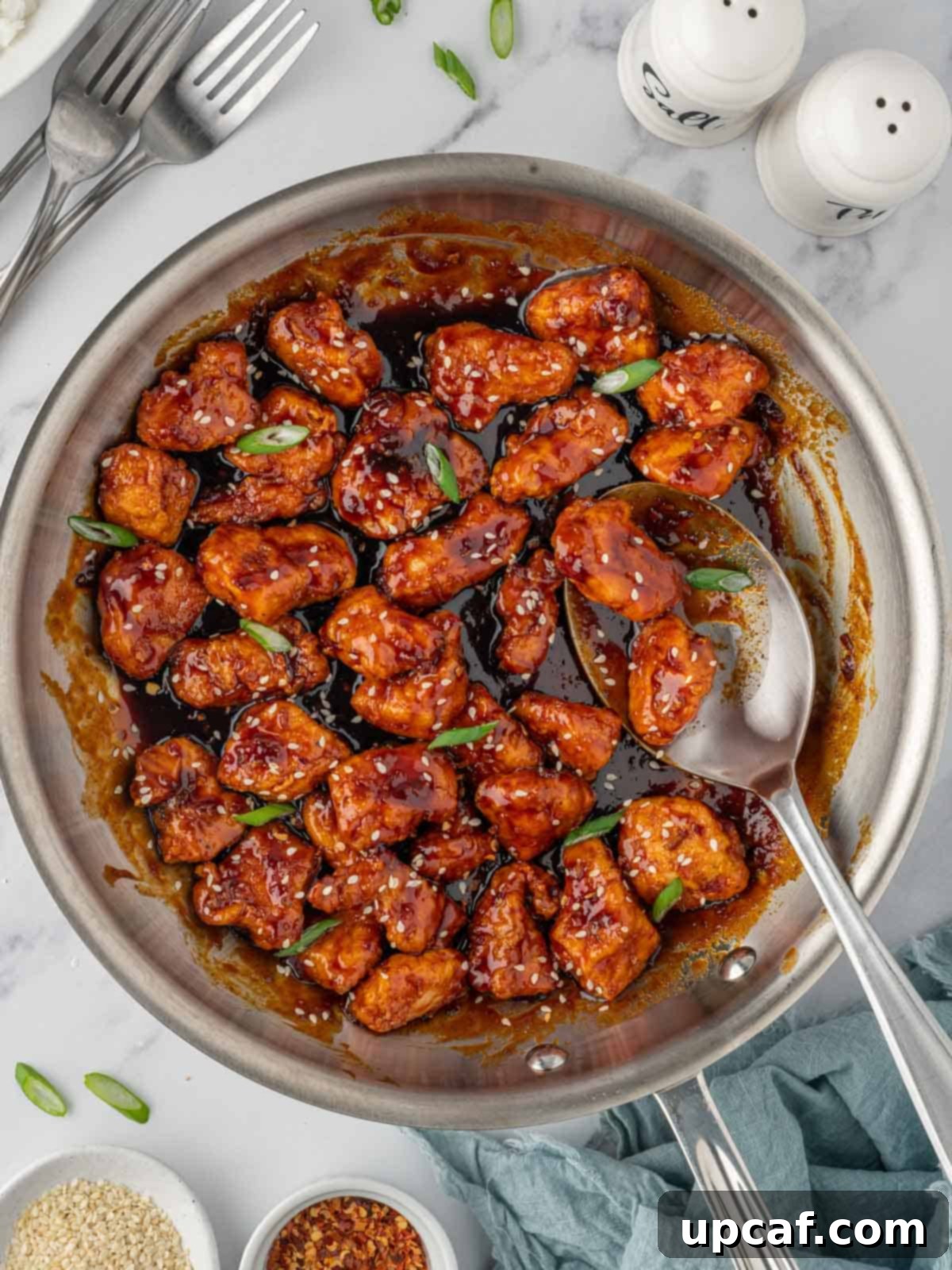
This Korean Gochujang chicken recipe stands out for its healthier preparation method: it’s baked, not fried. This approach not only reduces fat content but also simplifies the cooking process, making it accessible for home cooks of all skill levels. The sauce itself is a masterpiece of balance – sweet enough to entice, spicy enough to excite, and brimming with the complex umami notes that make gochujang so beloved. It’s a flavor profile that guarantees repeat performances in your kitchen. If you’re someone who relishes discovering bold new tastes and infusing everyday proteins like chicken with an adventurous spirit, then these Crispy Baked Gochujang Chicken Bites are destined to become a new favorite. They offer a gourmet experience with homemade ease, delivering restaurant-quality flavor right to your dining table.
For those who are already avid fans of Gochujang and its incredible versatility, you’ll be thrilled to explore more dishes that harness its power. Don’t miss out on my Korean Crispy Fried Chicken, a true classic, or the smoky, savory delight of my Korean BBQ Chicken Skewers. Each recipe offers a unique way to enjoy this iconic Korean chili paste.
Why You’ll Love This Healthier Gochujang Chicken Recipe
There are countless reasons to fall in love with these Crispy Baked Gochujang Chicken Bites, making them a staple in your meal rotation. Beyond their incredible taste, they offer practical benefits that cater to modern lifestyles:
- It’s Quick and Simple. In a world where time is a precious commodity, this recipe is a godsend. It comes together in approximately 40 minutes from start to finish, making it an ideal choice for busy weeknights when you crave something satisfying and flavorful without spending hours in the kitchen. The straightforward steps mean less fuss and more enjoyment.
- It’s a Crowd-Pleaser. Planning a family dinner or entertaining guests? This Gochujang chicken is guaranteed to be a hit. Its universally appealing sweet and spicy profile, combined with the crispy texture, makes it a dish that delights all ages and palates. Plus, the recipe is incredibly easy to double or even triple, ensuring you can effortlessly feed a large gathering without extra stress. Enjoy the gourmet flavors of your favorite takeout, but without the hefty price tag and in the comfort of your own home.
- It’s Sweet and Spicy with Umami Depth. The signature gochujang sauce is expertly crafted to strike a perfect balance between its inherent heat and a delightful sweetness. This creates a nuanced flavor that is both exciting and comforting, preventing either extreme from overpowering the other. The fermented nature of gochujang also infuses the dish with a profound umami flavor, adding a savory depth that is truly irresistible and leaves you craving more after every bite.
- It’s a Healthier Alternative. By opting for baking instead of deep-frying, this recipe significantly reduces the fat content without sacrificing the coveted crispy texture. The cornstarch coating ensures a satisfying crunch, giving you all the joy of fried chicken with a lighter, more wholesome preparation. It’s a smart way to enjoy your favorite flavors guilt-free.
- It’s Highly Customizable. Whether you’re a heat-seeker or prefer a milder kick, this recipe can be easily adjusted to suit your spice preference. You can increase or decrease the amount of gochujang or red pepper flakes to achieve your desired level of heat. This flexibility makes it perfect for households with varying tolerances for spice, ensuring everyone can enjoy a meal tailored to their liking.
Chicken Gochujang Ingredients
Crafting these delicious Gochujang Chicken Bites requires a few key ingredients, most of which are readily available. Here’s what you’ll need, along with some insights into each component:
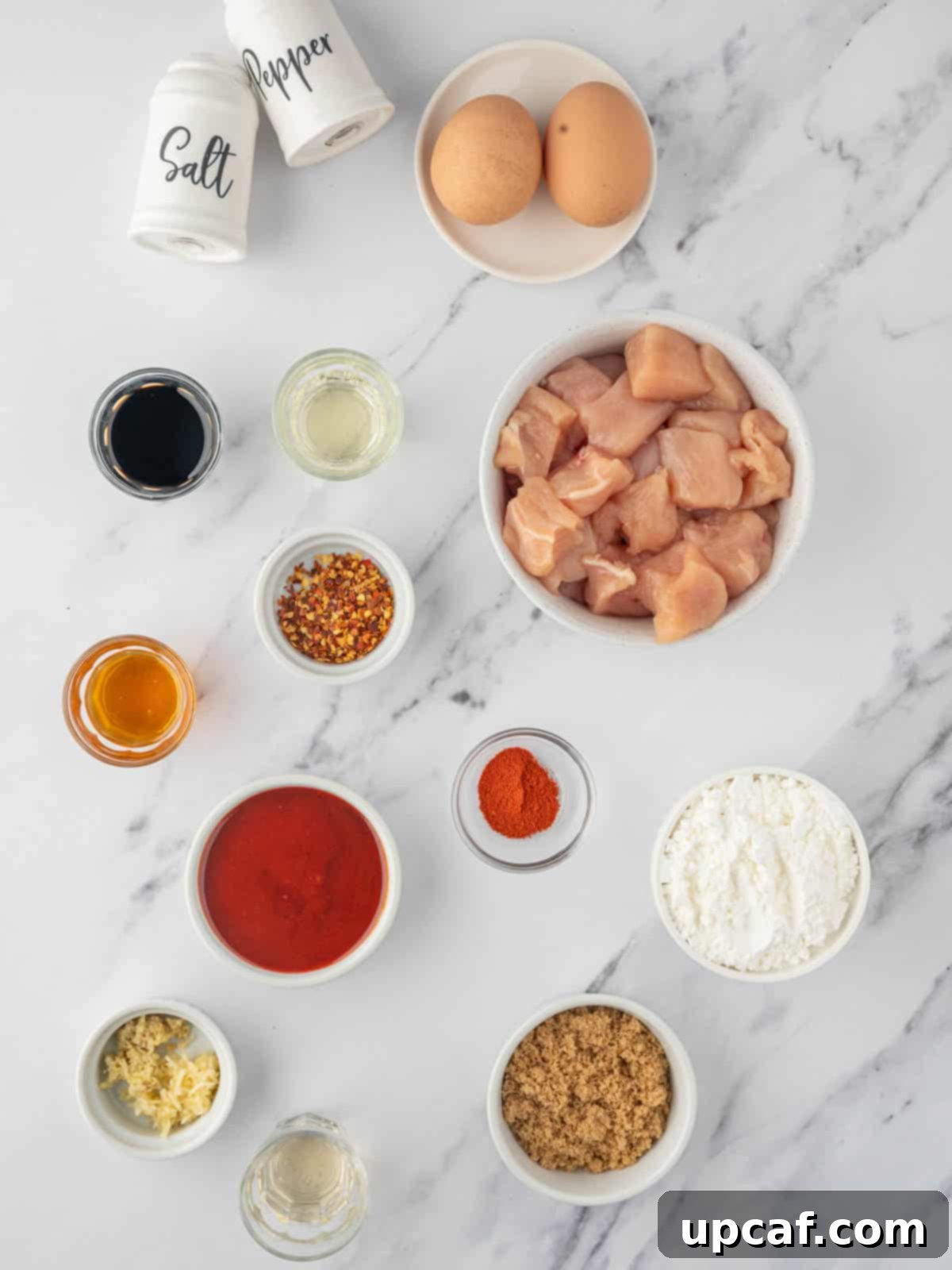
- Chicken: For convenience and quick cooking, we recommend using boneless, skinless chicken breast cut into uniform cubes. This ensures even baking and bite-sized pieces perfect for tossing in the sauce. Alternatively, boneless, skinless chicken thighs can be used for a slightly richer flavor and more tender texture.
- Cornstarch: This is the secret to achieving that irresistible crispy exterior without deep-frying. Cornstarch creates a light, thin coating that crisps up beautifully in the oven, giving you that satisfying crunch.
- Seasoning: To infuse flavor into the chicken itself, the cornstarch coating is seasoned with a blend of paprika, salt, and ground black pepper. Paprika adds a subtle warmth and color, while salt and pepper enhance the natural taste of the chicken.
- Eggs: Two beaten room-temperature eggs are essential for helping the cornstarch adhere properly to the chicken pieces. Bringing eggs to room temperature makes them easier to beat and creates a smoother coating. Seasoning the eggs with a pinch of salt and pepper further layers the flavor.
For the Gochujang Sauce
The star of the show, the Gochujang sauce, is a vibrant mix of sweet, spicy, and savory elements. Each ingredient plays a crucial role in creating its complex and addictive profile:
- Gochujang: This popular Korean chili paste is the heart and soul of the sauce. It’s a fermented condiment that delivers a unique blend of sweet, savory, and spicy flavors with a subtle tang. You can typically find it in the Asian aisle of most well-stocked grocery stores or at specialty Asian markets.
- Sweeteners: A combination of light brown sugar and honey provides a balanced sweetness that complements the heat of the gochujang. For a deeper, molasses-like flavor, you can use dark brown sugar. If you prefer, agave nectar or maple syrup can be substituted for honey, catering to different dietary preferences.
- Soy Sauce: Essential for adding a rich, savory umami depth to the sauce. Opt for a low-sodium soy sauce if you are mindful of salt intake, and adjust seasoning accordingly.
- Rice Vinegar: This mild, slightly sweet vinegar brightens the sauce and adds a subtle tang that cuts through the richness, balancing the overall flavor profile. Apple cider vinegar can be used as a substitute if rice vinegar is not available, though it has a slightly stronger flavor.
- Sesame Oil: A drizzle of toasted sesame oil (not untoasted) provides a distinctive nutty aroma and flavor, a hallmark of many Asian cuisines. A little goes a long way in adding depth.
- Aromatics: Freshly grated ginger and minced garlic are indispensable, infusing the sauce with their pungent, aromatic notes that elevate the entire dish. Always use fresh for the best flavor.
- Crushed Red Pepper Flakes: For those who love an extra kick, crushed red pepper flakes offer an additional layer of heat. You can easily adjust the amount or omit them entirely if you prefer a milder version, making the dish perfect for all spice tolerances.
- Garnishes: Toasted sesame seeds and freshly chopped green onions (scallions) are perfect for garnishing. They add a fresh, pungent crunch and a beautiful visual appeal, enhancing both the flavor and presentation of the finished dish.
How To Make Gochujang Chicken
Making these Crispy Baked Gochujang Chicken Bites is a straightforward process, designed to deliver maximum flavor with minimal effort. Follow these simple steps for a truly delicious meal:
- Prepare the Equipment: Begin by preheating your oven to 375 degrees F (190 degrees C). This ensures the oven is at the correct temperature for even cooking. Line a large baking tray with parchment paper. Parchment paper prevents sticking and makes cleanup a breeze. Set the prepared baking tray aside.
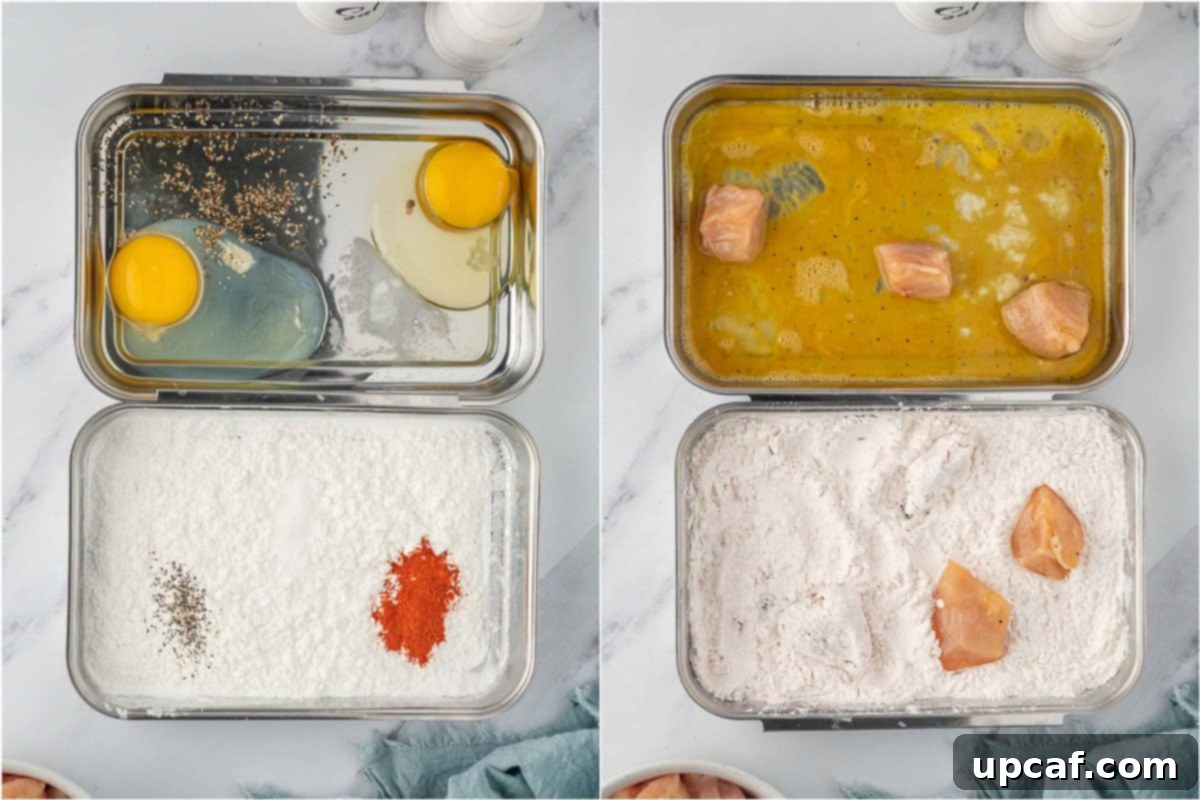
- Cube and Dredge the Chicken: Carefully cut the chicken breast (or thighs) into uniform bite-sized cubes, aiming for pieces approximately 1 to 1.5 inches in size. This consistency is crucial for even cooking. In a wide, shallow bowl, combine the cornstarch, paprika, ½ teaspoon of salt, and ½ teaspoon of black pepper. Mix thoroughly to create your seasoned dredging mixture. In a separate bowl, whisk together the two room-temperature eggs with the remaining ½ teaspoon of salt and ½ teaspoon of pepper. Now, create your dredging station: first, coat each chicken cube thoroughly in the cornstarch mixture, ensuring it’s fully covered. Then, dip the cornstarch-coated chicken into the egg mixture, letting any excess drip off. Finally, return the chicken to the cornstarch mixture for a second coating. Shake off any excess flour before placing the coated chicken pieces in a single layer on your prepared baking tray, making sure they are not touching.
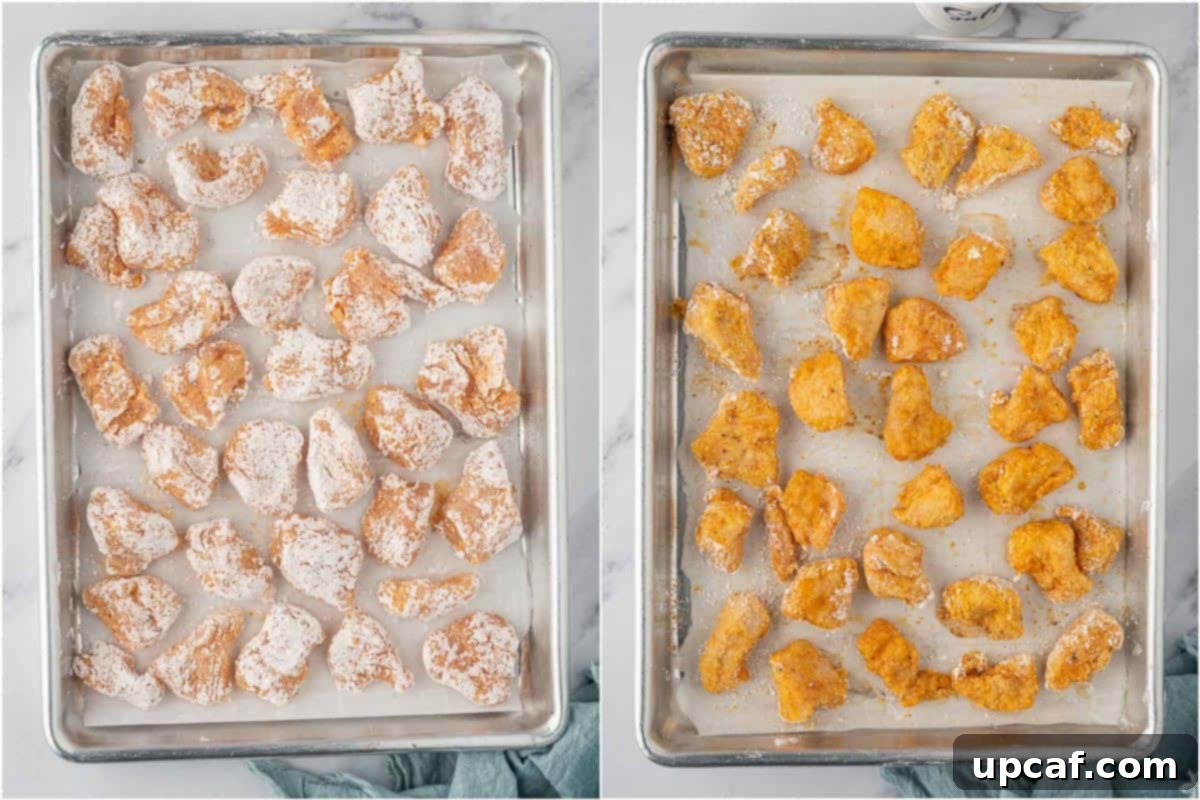
- Bake for Crispy Perfection: Transfer the baking tray to the preheated oven. Bake the chicken pieces for 20-25 minutes, or until they are fully cooked through, golden brown, and delightfully crispy. To ensure even crispiness, it’s a good idea to flip the chicken pieces halfway through the baking time. The internal temperature of the chicken should reach 165 degrees F (74 degrees C) when tested with a meat thermometer.

- Prepare the Gochujang Chicken Sauce: While the chicken is baking, prepare your irresistible Gochujang sauce. In a medium skillet or saucepan, combine all the sauce ingredients: Gochujang, light brown sugar, soy sauce, honey, rice vinegar, sesame oil, grated ginger, minced garlic, and crushed red pepper flakes (if using). Heat the mixture over medium heat, stirring constantly, for a couple of minutes until the sugar dissolves and the sauce begins to warm through and slightly thicken. The sauce should be glossy and fragrant.
- Toss Chicken and Sauce: Once the chicken bites are baked to crispy perfection, remove them from the oven. Immediately add the warm, baked chicken bites to the skillet with the prepared Gochujang sauce. Toss gently but thoroughly, ensuring each crispy chicken piece is generously coated in the sweet, spicy, and sticky sauce.
- Garnish and Serve: Transfer the sauced Gochujang chicken to a serving platter. Garnish generously with toasted sesame seeds and freshly chopped green onions for added flavor, texture, and visual appeal. Serve the Gochujang chicken immediately while it’s still warm and the chicken is at its crispiest. It pairs wonderfully with a bed of fluffy white rice.
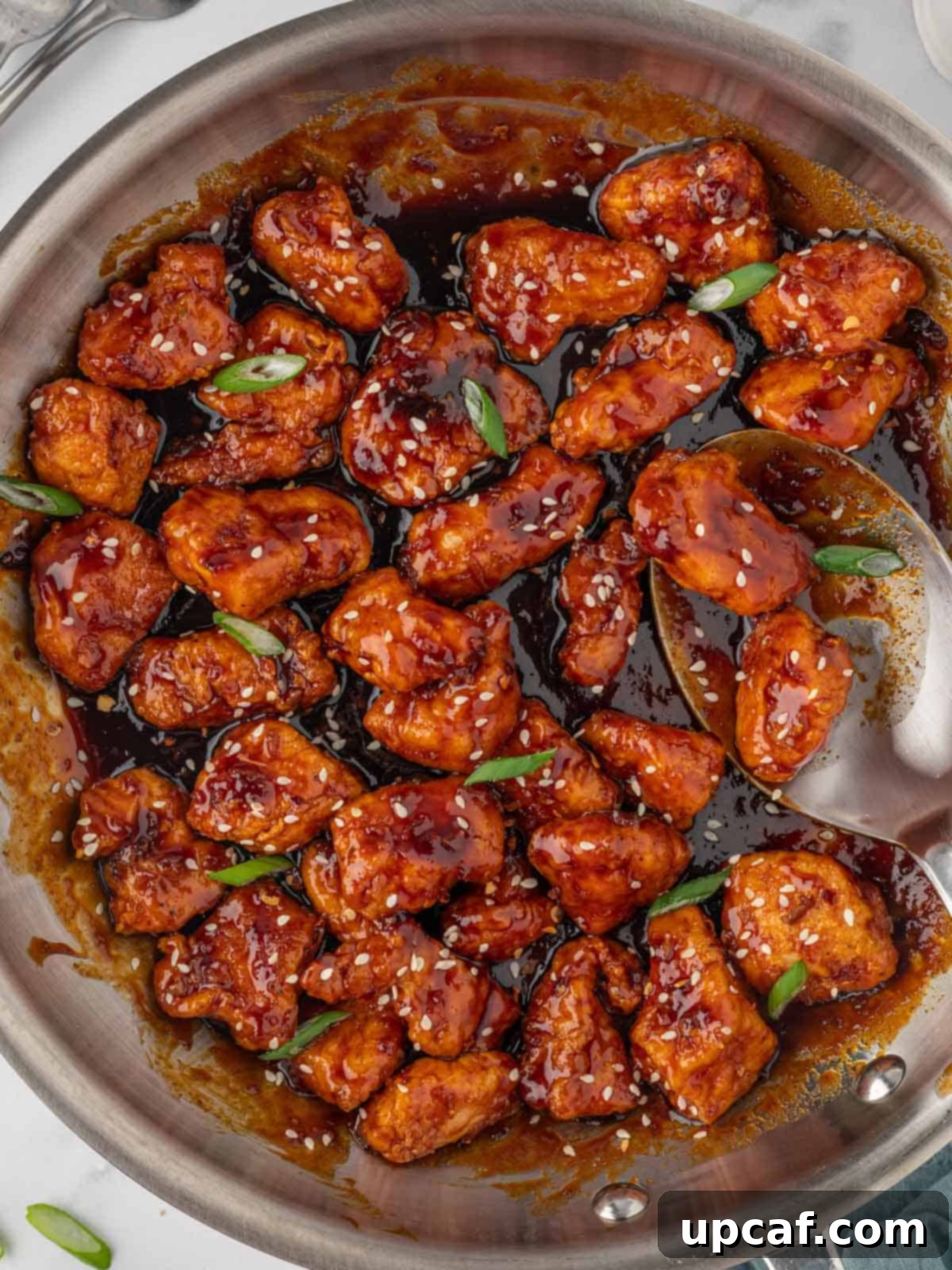
Tips To Make Korean Gochujang Chicken
Achieving perfectly crispy and flavorful Gochujang chicken is simple with these helpful tips and tricks:
- Uniform Chicken Pieces: Always cut your chicken into similar-sized pieces. This ensures that all the chicken cooks evenly at the same rate, preventing some pieces from drying out while others are still undercooked.
- Consider Chicken Thighs: While chicken breast is excellent, boneless, skinless chicken thighs can be used as an alternative. Thighs offer a slightly richer flavor and tend to stay more moist and tender, even if slightly overcooked.
- Room Temperature Eggs: Bring your eggs to room temperature before beating them. Room temperature eggs have a runnier consistency, making them easier to whisk smoothly and providing a more even coating for the chicken.
- Flip for Even Crispiness: For maximum crispiness and even browning on all sides, remember to turn the chicken pieces halfway through the baking process.
- Use a Wire Rack: For truly exceptional crispiness, consider cooking the chicken on an oven-proof wire rack placed over your parchment-lined baking sheet. This allows air to circulate around all sides of the chicken, resulting in an even crispier bite.
- Thicken the Sauce: If you desire a thicker, more intensely sticky sauce, simply cook the sauce longer on medium heat, allowing it to simmer and reduce further. Stir occasionally to prevent burning.
- Toss Just Before Serving: To maintain the optimal crispiness of your baked chicken, toss it with the Gochujang sauce just before you are ready to serve. This prevents the sauce from making the chicken soggy.
- Serve Sauce on the Side: For those who prefer to control the amount of sauce or like an extra crispy experience, you can serve the Gochujang sauce as a delicious dipping sauce on the side.
- Don’t Skimp on Garnishes: Always garnish with toasted sesame seeds and freshly chopped green onions. These not only add a beautiful visual touch but also contribute a fresh, nutty flavor that complements the richness of the chicken.
- Adjust Spice Levels: Gochujang can vary in heat, and personal preference differs. Start with the recommended amount, then taste and adjust. For less spice, reduce gochujang and red pepper flakes. For more, feel free to add a bit more of both.
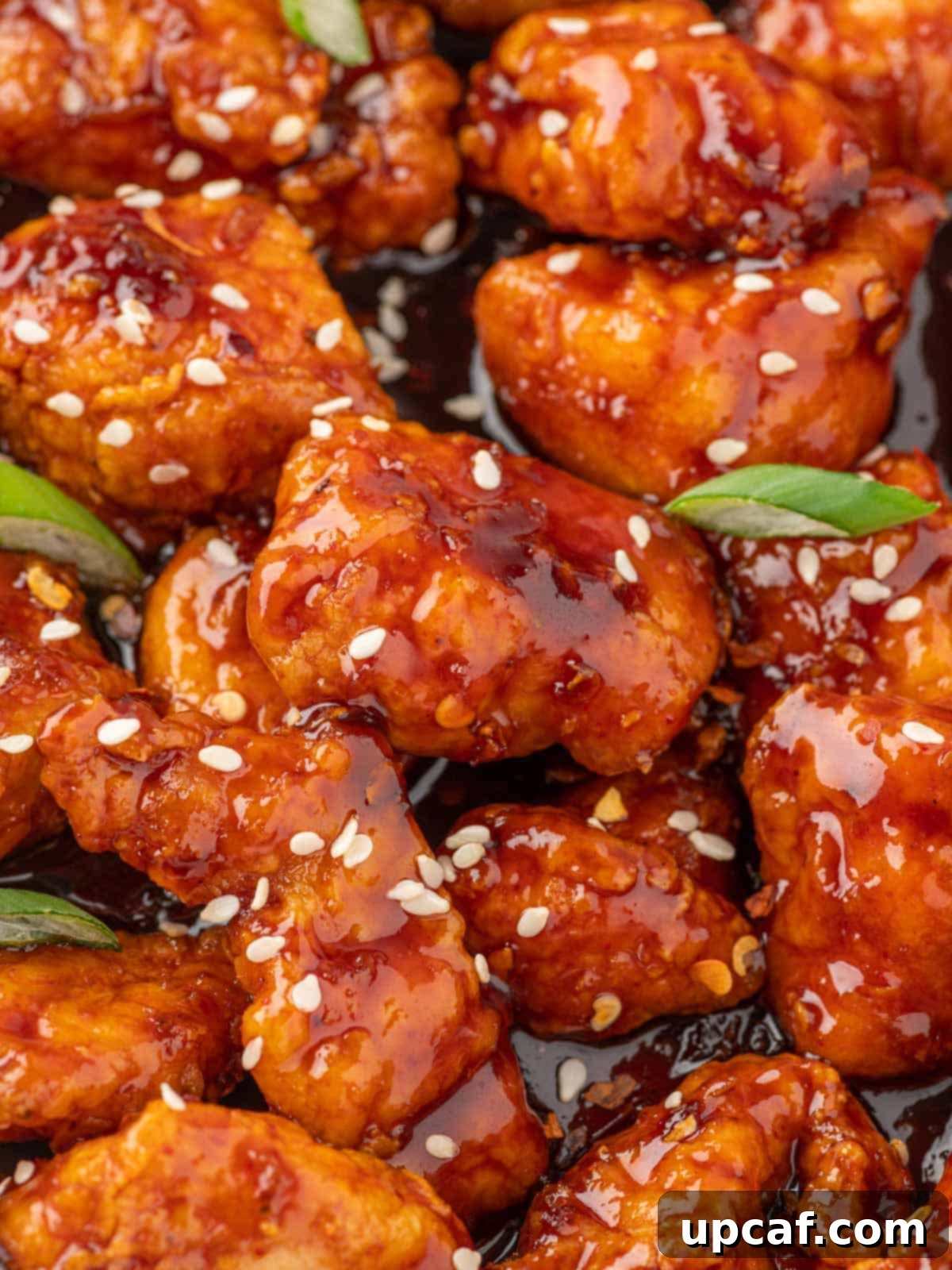
Frequently Asked Questions
Yes, Gochujang paste inherently carries a significant amount of heat, alongside its distinctive sweetness and savory notes. The spice level in this recipe can be easily adjusted to suit your preference. To begin, you can reduce the amount of Gochujang paste to ½ – 1 tablespoon and omit the crushed red pepper flakes. Taste the sauce, and if you desire more heat, gradually add more Gochujang or red pepper flakes until it reaches your preferred spice level.
Absolutely! While boneless, skinless chicken breast is a popular choice for its lean protein and convenience, boneless, skinless chicken thighs are an excellent alternative. Chicken thighs tend to be more forgiving, remaining incredibly tender and juicy even when cooked slightly longer, and they offer a richer, more pronounced chicken flavor that many people prefer.
Gochujang paste, a staple Korean condiment, is becoming increasingly accessible. You can typically find jars of Gochujang in the international or Asian food aisle of most large grocery stores. For a wider selection and potentially more authentic brands, consider visiting an Asian market or specialty food store. Its unique sweet, spicy, and subtly funky flavor, a result of the traditional fermentation process, makes it a distinct and essential ingredient for this recipe.
Leftovers of Gochujang Chicken can be stored in an airtight container in the refrigerator for up to four days. To reheat, the best methods are using a skillet on the stovetop over medium heat or warming it in the oven at 300°F (150°C) until heated through. These methods help to retain some of the chicken’s crispiness. While you can microwave the chicken, be aware that it tends to lose its crispy texture and may become a bit mushy.
Yes, you can freeze leftover Korean Gochujang Chicken for future enjoyment. Place the cooled chicken in a freezer-safe bag or airtight container and freeze for up to 3 months. When you’re ready to enjoy it, defrost the chicken overnight in the refrigerator. To reheat, bake it in a preheated oven at 350°F (175°C) until it’s warmed through and the chicken regains some of its crispiness.
These flavorful chicken bites are incredibly versatile and pair well with a variety of sides. They are perfect served over a bed of fluffy white rice, absorbing all the delicious sauce. For a noodle option, consider Vegetarian Lo Mein. If you prefer a rice-based side with more flavor, Fried Rice is an excellent choice. To complete your meal with vegetables, try them with Parmesan Roasted Glazed Carrots, savory Roasted Garlic Butter Mushrooms, or tender Roasted Brussels Sprouts. Feel free to pair it with your favorite steamed or roasted vegetables for a balanced and satisfying meal.
Several factors contribute to ultra-crispy baked chicken. First, ensure your chicken pieces are cut uniformly and aren’t overcrowded on the baking sheet; leave space between each piece for air circulation. Second, don’t skimp on the cornstarch coating – a double dredge works wonders. Finally, for an even crispier result, bake the chicken on a wire rack placed over a baking sheet. This lifts the chicken, allowing hot air to circulate all around it, preventing the bottom from becoming soggy.
To make this Gochujang chicken recipe gluten-free, you’ll need to make a couple of substitutions. Ensure you use a gluten-free Gochujang brand (some contain wheat) and swap regular soy sauce for Tamari, which is a gluten-free alternative. All other ingredients are naturally gluten-free. Always double-check ingredient labels to ensure they meet your dietary requirements.
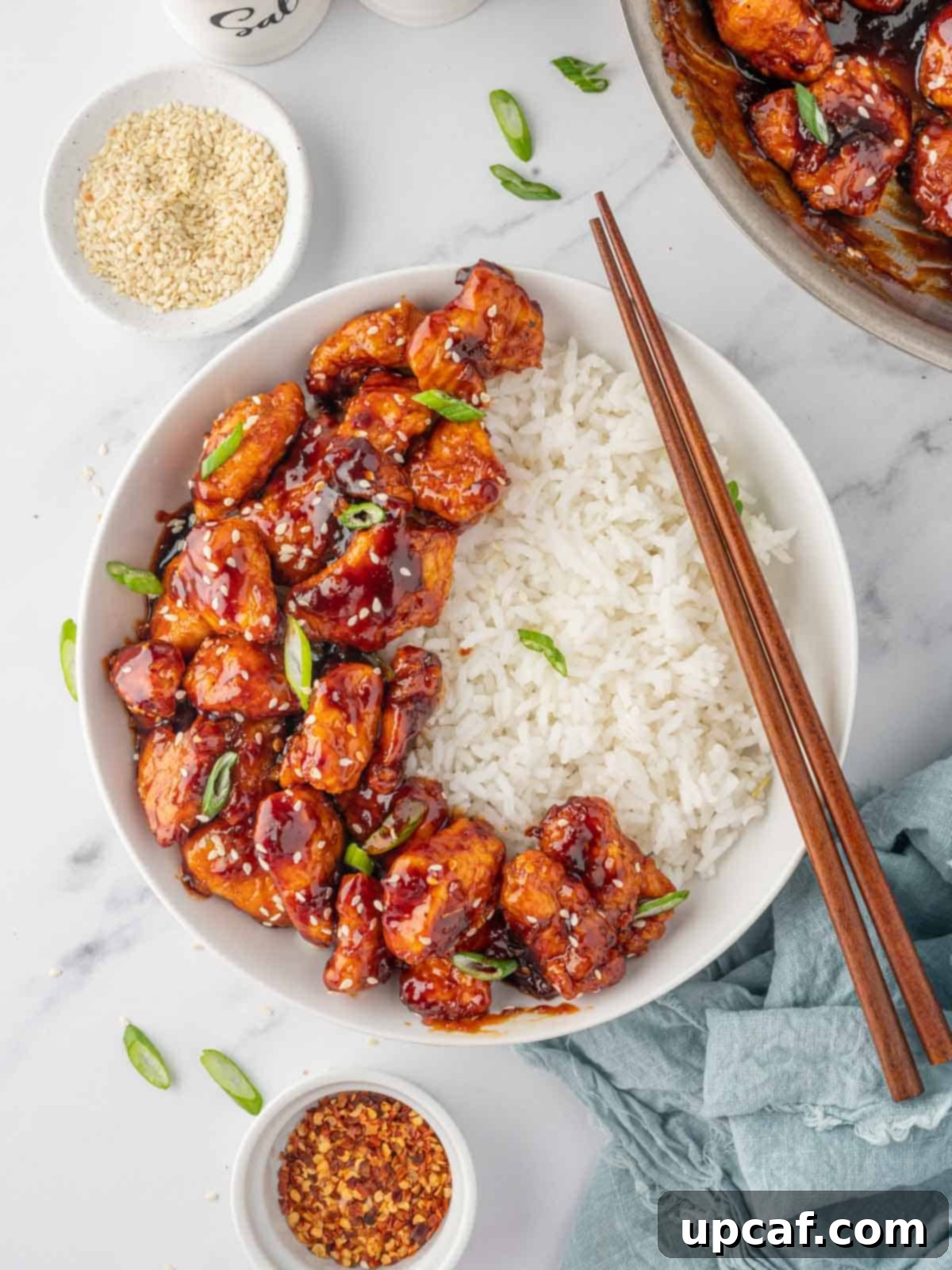
More Sweet and Spicy Chicken Recipes
If you’re a fan of bold flavors and find yourself drawn to the tantalizing combination of sweet and spicy, you’ll love exploring these other chicken recipes:
- Homemade Sweet and Sour Chicken
- Sweet Thai Chili Chicken Stir Fry
- Sweet and Spicy Asian Chicken
- Creamy Spicy Chicken Pasta
- Spicy Sriracha Chicken
I sincerely hope you enjoy discovering and creating all the delicious recipes I share with you, especially these delightful Crispy Baked Gochujang Chicken Bites. It’s a dish I’m passionate about, and I encourage you to try it in your own kitchen. I’m confident you’ll find it incredibly satisfying and a worthy addition to your recipe collection. Please do give it a try, savor every bite, and consider rating it and sharing it with your loved ones!
If you prepare this recipe and enjoy it as much as I do, please take a moment to leave a star rating and share your comments below. Your feedback is invaluable and helps others discover these wonderful dishes. For all my latest social posts, delicious recipes, and culinary inspiration, be sure to follow me at Cookin’ With Mima on FACEBOOK |INSTAGRAM |PINTEREST.

Best Gochujang Chicken Bites
Ingredients
- 2 whole chicken breast, cut into cubes
- ½ cup cornstarch
- 1 teaspoon paprika
- 1 teaspoon salt, divided
- 1 teaspoon ground black pepper, divided
- 2 whole eggs
For the Gochujang sauce
- ¼ cup Gochujang sauce, sauce or paste
- ⅓ cup light brown sugar
- 2 tablespoons soy sauce
- 3 tablespoons honey
- 1½ tablespoon rice vinegar
- 1 tablespoon sesame oil
- 1 tablespoon ginger, grated
- 2 teaspoon garlic, minced
- ½ teaspoon crushed red pepper flakes
- 1 teaspoon sesame seeds, to garnish
- Chopped green onions, to garnish
Instructions
- Preheat the oven to 375 degrees F (190 degrees C). Line a baking tray with parchment paper and keep it aside.
- Cut the chicken into uniform bite-size pieces and keep them aside.
- In a wide bowl, combine cornstarch, paprika, ½ teaspoon salt, and ½ teaspoon black pepper. Mix well.
- In another bowl, combine eggs, ½ teaspoon salt, and ½ teaspoon pepper and beat well.
- Add the chicken cubes and coat them thoroughly in the cornstarch mixture. Then, dip into the egg mixture and coat again with the cornstarch mixture. Shake off the excess flour and place the chicken on the prepared baking tray in a single layer.
- Bake the chicken pieces for 20-25 minutes, flipping halfway through, until they are cooked through and crispy.
- Meanwhile, prepare the Gochujang sauce by combining all the sauce ingredients (Gochujang, brown sugar, soy sauce, honey, rice vinegar, sesame oil, ginger, garlic, and red pepper flakes) in a skillet. Heat on medium for a couple of minutes until the sugar dissolves and the sauce thickens slightly.
- Add the baked chicken bites to the warm sauce in the skillet and toss gently to coat each piece evenly.
- Garnish the Gochujang chicken with sesame seeds and chopped green onions.
- Serve Gochujang chicken immediately with rice while it is still warm and crispy.
Notes
- Cut the chicken into similar-sized pieces for even cooking.
- Use chicken thighs in place of chicken breast for a juicier result.
- Bring the eggs to room temperature; they will be easier to beat and create a smoother coating.
- Turn the chicken halfway through cooking for consistent crispiness.
- Cook the chicken on an oven-proof wire rack over a baking sheet for crispier pieces.
- For a thicker, stickier sauce, cook the sauce longer, allowing it to reduce more.
- Toss the chicken with the sauce just before serving to maintain crispiness.
- You can also serve the sauce as a dip on the side.
- Garnish generously with sesame seeds and green onions for extra flavor and visual appeal.
Nutrition
Calories: 314kcal
Carbohydrates: 43g
Protein: 23g
Fat: 6g
Saturated Fat: 1g
Polyunsaturated Fat: 1g
Monounsaturated Fat: 2g
Trans Fat: 0.02g
Cholesterol: 136mg
Sodium: 1228mg
Potassium: 481mg
Fiber: 1g
Sugar: 24g
Vitamin A: 501IU
Vitamin C: 4mg
Calcium: 45mg
Iron: 2mg
Like this recipe? Rate and comment below!
